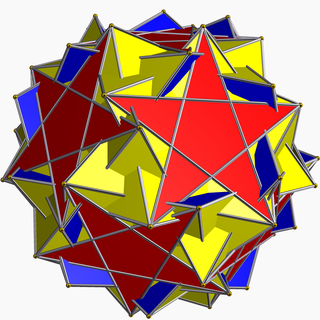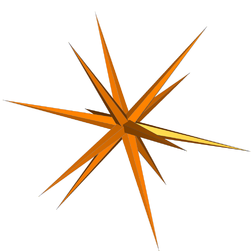| Inverted snub dodecadodecahedron | |
|---|---|

| |
| Type | Uniform star polyhedron |
| Elements | F = 84, E = 150 V = 60 (χ = −6) |
| Faces by sides | 60{3}+12{5}+12{5/2} |
| Coxeter diagram | |
| Wythoff symbol | | 5/3 2 5 |
| Symmetry group | I, [5,3]+, 532 |
| Index references | U60, C76, W114 |
| Dual polyhedron | Medial inverted pentagonal hexecontahedron |
| Vertex figure |
 3.3.5.3.5/3 |
| Bowers acronym | Isdid |

In geometry, the inverted snub dodecadodecahedron (or vertisnub dodecadodecahedron) is a nonconvex uniform polyhedron, indexed as U60. [1] It is given a Schläfli symbol sr{5/3,5}.
Cartesian coordinates
Cartesian coordinates for the vertices of an inverted snub dodecadodecahedron are all the even permutations of
with an even number of plus signs, where is the golden ratio, and α is the negative real root of Taking the odd permutations of the above coordinates with an odd number of plus signs gives another form, the enantiomorph of the other one. Taking α to be the positive root gives the snub dodecadodecahedron.
Related polyhedra
Medial inverted pentagonal hexecontahedron
| Medial inverted pentagonal hexecontahedron | |
|---|---|

| |
| Type | Star polyhedron |
| Face |

|
| Elements | F = 60, E = 150 V = 84 (χ = −6) |
| Symmetry group | I, [5,3]+, 532 |
| Index references | DU60 |
| dual polyhedron | Inverted snub dodecadodecahedron |

The medial inverted pentagonal hexecontahedron (or midly petaloid ditriacontahedron) is a nonconvex isohedral polyhedron. It is the dual of the uniform inverted snub dodecadodecahedron. Its faces are irregular nonconvex pentagons, with one very acute angle.
Proportions
Denote the golden ratio by , and let be the largest (least negative) real zero of the polynomial . Then each face has three equal angles of , one of and one of . Each face has one medium length edge, two short and two long ones. If the medium length is , then the short edges have length and the long edges have length The dihedral angle equals . The other real zero of the polynomial plays a similar role for the medial pentagonal hexecontahedron.
See also
References
- Wenninger, Magnus (1983), Dual Models, Cambridge University Press, ISBN 978-0-521-54325-5, MR 0730208 p. 124
- ^ Roman, Maeder. "60: inverted snub dodecadodecahedron". MathConsult.
External links
- Weisstein, Eric W. "Medial inverted pentagonal hexecontahedron". MathWorld.
- Weisstein, Eric W. "Inverted snub dodecadodecahedron". MathWorld.
![{\displaystyle {\begin{array}{crrrc}{\Bigl (}&\pm \,2\alpha \ ,&\pm \,2\ ,&\pm \,2\beta \ &{\Bigr )},\\[2pt]{\Bigl (}&\pm {\bigl [}\alpha +{\frac {\beta }{\varphi }}+\varphi {\bigr ]},&\pm {\bigl [}-\alpha \varphi +\beta +{\frac {1}{\varphi }}{\bigr ]},&\pm {\bigl [}{\frac {\alpha }{\varphi }}+\beta \varphi -1{\bigr ]}&{\Bigr )},\\[2pt]{\Bigl (}&\pm {\bigl [}-{\frac {\alpha }{\varphi }}+\beta \varphi +1{\bigr ]},&\pm {\bigl [}-\alpha +{\frac {\beta }{\varphi }}-\varphi {\bigr ]},&\pm {\bigl [}\alpha \varphi +\beta -{\frac {1}{\varphi }}{\bigr ]}&{\Bigr )},\\[2pt]{\Bigl (}&\pm {\bigl [}-{\frac {\alpha }{\varphi }}+\beta \varphi -1{\bigr ]},&\pm {\bigl [}\alpha -{\frac {\beta }{\varphi }}-\varphi {\bigr ]},&\pm {\bigl [}\alpha \varphi +\beta +{\frac {1}{\varphi }}{\bigr ]}&{\Bigr )},\\[2pt]{\Bigl (}&\pm {\bigl [}\alpha +{\frac {\beta }{\varphi }}-\varphi {\bigr ]},&\pm {\bigl [}\alpha \varphi -\beta +{\frac {1}{\varphi }}{\bigr ]},&\pm {\bigl [}{\frac {\alpha }{\varphi }}+\beta \varphi +1{\bigr ]}&{\Bigr )},\end{array}}}](https://wikimedia.org/api/rest_v1/media/math/render/svg/2c98f3d7fd373cecd5a28e79e9dc36acbefb52a6)













